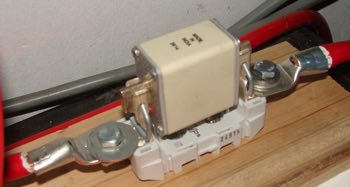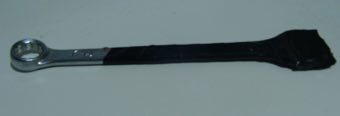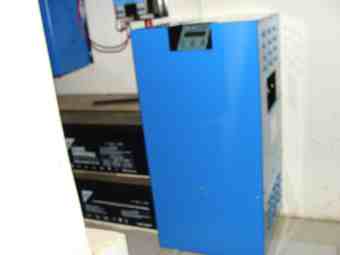- Bernard Preston homepage
- Solar geek
- Knifeblade Fuse
Knifeblade fuse
A knifeblade fuse makes your inverter for home a lot safer; there is an enormous amount of energy stored in those batteries.
This page was updated on 16th October, 2023.
Carefully and correctly managed the batteries will provide years of energy to your home; one slip and you could have a huge electrical-fire.

The current flowing from eight large 200Ah batteries in the event of a catastrophic short-circuit is potentially enormous; and the damage to the owner of a solar generator severe.
It's really a very simple system with a knifeblade block which I have mounted on a piece of old timber just so it does not fall on its side; into it you can fit fuses of different sizes that will melt in the event of a high short-circuit current.
I've chosen the 130 amp fuse giving me a ceiling of 6kW with my large inverter. I could have gone higher; but I never go over this figure since my PV panels and batteries would not handle a heavier current.
If I add more panels in the future capable of delivering say 7kW then I may simply purchase a larger fuse to slip into the holder.
One can purchase more sophisticated fuses that fit together in a modular design with several poles; I've chosen to protect only the negative-cable from the batteries to the inverter.
Knifeblade fuse
Knifeblade fuse is a simple and inexpensive device that will break the heavy current in the event of a short-circuit.
Electrical fires are not pretty and with the huge amount of solar energy stored in these batteries, a short-circuit could potentially be very hazardous.
An electrician friend with many years experience in the industry recommended it recently to protect myself and my home from a fire.
Step-one is to turn off the inverter and drop all the relevant breakers.
Most important next is to remove one of the leads from the batteries to the inverter; I chose the negative but the positive would have been equally good.
Disconnect the other end of this heavy-duty battery cable from the inverter and take it to an electrical company to cut the wire cleanly; it's an expensive device that the owner of just one solar generator will not use frequently.
Where the lead has been cut simply fit two large lugs and crimp them securely.
Again attach the negative lead to the inverter terminal, and then onto the knifeblade fuse. Connect the other end to the opposite side and hence to the battery.
Tighten all bolts using exceptional care not to cross the spanner across two-terminals.

I've taped up one end of my spanner with insulation tape to make it absolutely impossible to short across two live battery terminals. The instantaneous current would be massive and cause severe burns.
Solar generator
Building a solar generator has been one of the most rewarding activities that I've ever undertaken; learning about little items like a knifeblade fuse was one very tiny part.
It takes considerable planning to build a solar generator from scratch. In the first instance considerable thought is needed. Therein lies a catch; I assumed I would want a Mickey-Mouse system just to supply lights and computers. A 2kW inverter for home would have been quite adequate with perhaps one kilowatt of photovoltaic panels and two 200Ah batteries; a 24V circuit.
Newsletter
Our newsletter is entitled "create a cyan zone" at your home, preserving both yourself and Mother Earth for future generations; and your family too, of course. We promise not to spam you with daily emails promoting various products. You may get an occasional nudge to buy one of my books.
Here are the back issues.
- Investing in long-term health
- Diseases from plastic exposure
- Intensive lifestyle management for obesity has limited value
- A world largely devoid of Parkinson's Disease
- The impact of friendly bacteria in the tum on the prevention of cancer
- There's a hole in the bucket
- Everyone is talking about weight loss drugs
- Pull the sweet tooth
- If you suffer from heartburn plant a susu
- Refined maize meal and stunting
- Should agriculture and industry get priority for water and electricity?
- Nature is calling
- Mill your own flour
- Bake your own sourdough bread
- Microplastics from our water
- Alternative types of water storage
- Wear your clothes out
- Comfort foods
- Create a bee-friendly environment
- Go to bed slightly hungry
- Keep bees
- Blue zone folk are religious
- Reduce plastic waste
- Family is important
- What can go in compost?
- Grow broad beans for longevity
- Harvest and store sunshine
- Blue zone exercise
- Harvest and store your rainwater
- Create a cyan zone at your home
Little did I realise how the greed-factor would kick in; discovering that the sun brings a free gift for those who will take the time to collect, store and use it safely meant several needlessly expensive upgrades.
If I may have the temerity to strongly recommend it, never go less than a 48-volt system, which means a minimum of four 12V lead-cell batteries; or better still a lithium ion.
5kW of PV panels and a 5kW inverter make up the balance. I've yet to meet someone with a Mickey-Mouse solar generator who is happy with what he or she has.
Go moderately big or don't even make a start is my suggestion; a small system will do little for the environment and will never satisfy your needs.
Inverter for home
The inverter for home with a built in safety knifeblade fuse is at the heart of your solar generator. It takes direct current from your batteries at 48 volts and steps it up to 110V or 220V alternating current that you can use to power computers, lights and a hot water kettle; and an electric lawnmower.
Buying too small an inverter for home is the commonest mistake most of us will make; you are using it at the limits of its capabilities and it will not last the night, figuratively speaking.
Like I said, boring with repetition but I feel strongly about it, never go less than 5kW; and preferably bite the bullet as I have done and purchase a 7kW or 10kW inverter. Then it hurts only once.

Indeed Big Boy was expensive but we can roast a chicken in the oven, use my heavy-duty carpentry thicknesser and pump water from the well all at the same time using it; during the day, that is when Mr Golden Sun, as my granddaughter calls him is delivering. The knifeblade fuse ensures we don't draw too much and damage either ourselves or components of our solar generator.
When browsing use right click and "Open Link in New Tab" or you may get a bad gateway signal.
Bernard Preston

Whilst Bernard Preston being a physics major has quite a lot of theoretical background concerning building a home solar generator, it's the small safety features like taped up spanners and using a knifeblade fuse that he has had to learn along the way.
Adjusting patients' spines, use of carpentry power tools and flying gliders has taught me to stop when weary; all of these are potentially dangerous activities when exhaustion sets in.
I stop the moment my body tells me that's enough; before the injury.
That was difficult in Holland when every day there were a very large number of patients booked; there were some dramas which you can read about in Stones in my Clog but in general my advice is to avoid an obviously overly-busy doctor of any ilk.
Frankly avoid an overly-busy anybody. If I burn my candle at both ends, it will not last the night; but oh my friends, and ah my foes it makes a glorious sight.
But it still won't last the night. The DC who took over from me when I retired in that practice dropped dead one lunchtime some six months later; it could have been me.
I strictly follow the same principle whether using machine tools, driving a car or working with such toys as a knifeblade fuse; stop before the accident.
Did you find this page interesting? How about forwarding it to a friend, or book and food junkie? Better still, a social mead tick would help.
- Bernard Preston homepage
- Solar geek
- Knifeblade Fuse
Address:
56 Groenekloof Rd,
Hilton, KZN
South Africa
Website:
https://www.bernard-preston.com